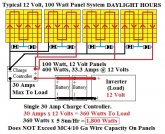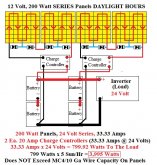JeepHammer
Solar Wizard
- Joined
- Nov 15, 2019
- Messages
- 1,149
I had a heated discussion with a guy planning a solar system about how much, and WHEN he was going to use power,
Should he put more money in panels/batteries because he used the power at night, or panels/charge controllers because he planned to use power in the daytime when panels were producing...
Charge Controllers being considerably less expensive than batteries or panels.
The same subject came up in a thread here yesterday (MUCH more polite!) and today, so I want to know what others think and are doing...
---------------------------
With REALLY SMALL 12 Volt systems, the types used in Vans, Trailers converted to campers, maybe a cabin,
Roof space seems to be a limiting factor,
4Ea. 100 Watt Panels, 30 Amp Charge Controller and 2 Batteries seems to be real common, so I'll run with that as an example.

Example, Before System Losses,
5 Peak Sun Hours,
4Ea. 100 Watt Panels, 400 Watts/Hour, 12 Volts, 33.33 Amps/Hour.
2 Ea. 12 Volt, 100 Amp Hour Batteries, 200 Amp Hours.
Batteries Discharged 50% or 1,000 Amp Hours.
1,000 Watts @ 12 Volts = 83.33 Amps
30 Amps/Hour x 12 Volts = 360 Watts/Hour From Charge Controller,
360 Watts/Hour x 2.78 Hours = 1,000 Watts/1kWh
2.78 Hours To Recharge Batteries
5 Peak Sun Hours (or more) Per Day, Minus 2.78 To Recharge Batteries,
Leaves 2.22 Sun Hours @ 360 Watts An Hour, 799 Watts Left.
799 Watts @ 110 Volts Left On The Table.
-------------------------------------------------------------------------------------

Example, Before System Losses:
5 Peak Sun Hours,
200 Watt Panels, 800 Watts/Hour, 12 Volts, 66.66 Amps/Hour.
4 Ea. 12 Volt, 100 Amp Hour Batteries, 400 Amp Hours.
Batteries Discharged 50%, 2,000 Amp Hours (2kWh)
2,000 Watts @ 12 Volts = 166.66 Amps
60 Amps/Hour x 12 Volts = 720 Watts/Hour From Charge Controllers,
720 Watts/Hour x 2.78 Hours = 2001 Watts (200 Amp Hours/2kWh)
2.78 Hours To Recharge Batteries
5 Peak Sun Hours (or more) Per Day Minus 2.78 To Recharge Batteries
Leaves 2.22 Hours @ 720 Watts An Hour, 1,598 Watts Left,
1,598 Watts At 110 Volts From Inverter Left On The Table.
------------------------------------

Example, Before System Losses:
5 Peak Sun Hours,
200 Watt Panels, 800 Watts/Hour, 24 Volts, 33.33 Amps/Hour.
4 Ea. 12 Volt, 100 Amp Hour Batteries, 400 Amp Hours Total.
Batteries 50% Discharged, 200 Amp Hours (2kWh, 2,000 Watts)
2,000 Watts @ 24 Volts = 83.33 Amps
33.33 Amps/Hour x 24 Volts = 799.92 Watts/Hour (200 Amp Hours/2kWh)
2.50 Hours To Recharge Batteries
5 Peak Sun Hours (or more) Per Day, Minus 2.5 To Recharge Batteries,
Leaves 2.5 Hours @ 799 Watts An Hour, 2,000 Watts Left,
2,000 Watts (or more) @ 110 Volts From Inverter Left On The Table That Does NOT Draw From Batteries.
----------------------------------------------------
2 Charge Controllers work best when they find the power point faster, and dump Amps into the Load End of the system (Batteries & Inverter) so the dirt cheap Charge Controllers aren't the best option.
With low internal resistance batteries, Like LiFePo4, the second charger will recharge batteries MUCH faster.
We all like seeing that 'Float', 'Charged' or ' ' Icon, and after that it's all excess Watts the panels are producing.
' Icon, and after that it's all excess Watts the panels are producing.
I set timers past the point where my batteries usually charge fully, Kicking on something I want done, using the excess production.
Everything from the crock pot to the washing machine.
Should he put more money in panels/batteries because he used the power at night, or panels/charge controllers because he planned to use power in the daytime when panels were producing...
Charge Controllers being considerably less expensive than batteries or panels.
The same subject came up in a thread here yesterday (MUCH more polite!) and today, so I want to know what others think and are doing...
---------------------------
With REALLY SMALL 12 Volt systems, the types used in Vans, Trailers converted to campers, maybe a cabin,
Roof space seems to be a limiting factor,
4Ea. 100 Watt Panels, 30 Amp Charge Controller and 2 Batteries seems to be real common, so I'll run with that as an example.

Example, Before System Losses,
5 Peak Sun Hours,
4Ea. 100 Watt Panels, 400 Watts/Hour, 12 Volts, 33.33 Amps/Hour.
2 Ea. 12 Volt, 100 Amp Hour Batteries, 200 Amp Hours.
Batteries Discharged 50% or 1,000 Amp Hours.
1,000 Watts @ 12 Volts = 83.33 Amps
30 Amps/Hour x 12 Volts = 360 Watts/Hour From Charge Controller,
360 Watts/Hour x 2.78 Hours = 1,000 Watts/1kWh
2.78 Hours To Recharge Batteries
5 Peak Sun Hours (or more) Per Day, Minus 2.78 To Recharge Batteries,
Leaves 2.22 Sun Hours @ 360 Watts An Hour, 799 Watts Left.
799 Watts @ 110 Volts Left On The Table.
-------------------------------------------------------------------------------------

Example, Before System Losses:
5 Peak Sun Hours,
200 Watt Panels, 800 Watts/Hour, 12 Volts, 66.66 Amps/Hour.
4 Ea. 12 Volt, 100 Amp Hour Batteries, 400 Amp Hours.
Batteries Discharged 50%, 2,000 Amp Hours (2kWh)
2,000 Watts @ 12 Volts = 166.66 Amps
60 Amps/Hour x 12 Volts = 720 Watts/Hour From Charge Controllers,
720 Watts/Hour x 2.78 Hours = 2001 Watts (200 Amp Hours/2kWh)
2.78 Hours To Recharge Batteries
5 Peak Sun Hours (or more) Per Day Minus 2.78 To Recharge Batteries
Leaves 2.22 Hours @ 720 Watts An Hour, 1,598 Watts Left,
1,598 Watts At 110 Volts From Inverter Left On The Table.
------------------------------------

Example, Before System Losses:
5 Peak Sun Hours,
200 Watt Panels, 800 Watts/Hour, 24 Volts, 33.33 Amps/Hour.
4 Ea. 12 Volt, 100 Amp Hour Batteries, 400 Amp Hours Total.
Batteries 50% Discharged, 200 Amp Hours (2kWh, 2,000 Watts)
2,000 Watts @ 24 Volts = 83.33 Amps
33.33 Amps/Hour x 24 Volts = 799.92 Watts/Hour (200 Amp Hours/2kWh)
2.50 Hours To Recharge Batteries
5 Peak Sun Hours (or more) Per Day, Minus 2.5 To Recharge Batteries,
Leaves 2.5 Hours @ 799 Watts An Hour, 2,000 Watts Left,
2,000 Watts (or more) @ 110 Volts From Inverter Left On The Table That Does NOT Draw From Batteries.
----------------------------------------------------
2 Charge Controllers work best when they find the power point faster, and dump Amps into the Load End of the system (Batteries & Inverter) so the dirt cheap Charge Controllers aren't the best option.
With low internal resistance batteries, Like LiFePo4, the second charger will recharge batteries MUCH faster.
We all like seeing that 'Float', 'Charged' or '
I set timers past the point where my batteries usually charge fully, Kicking on something I want done, using the excess production.
Everything from the crock pot to the washing machine.
Last edited:


